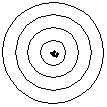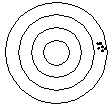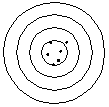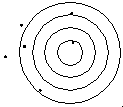- Accuracy
- Accuracy refers to how close a gage's measurements are to the true value. To assess accuracy, use a gage linearity and bias study () or a type 1 gage study ().
- Precision
- Precision refers to how close measurements are to each other. To assess precision, use a crossed, nested, or expanded gage R&R study ().
A gage can have any combination of accuracy and precision. For example, a gage that measures medication tablets is precise but not accurate if it measures the same 200 mg tablet as 205.54 mg, 205.43 mg, and 205.03 mg. The gage's measurements are close to each other, and thus precise. But they are not close to the true value (200 mg), and thus not accurate.

Accurate and precise
Measurements are close to the true value and are close to each other.

Precise but not accurate
Measurements are close to each other but not close to the true value.

Accurate but not precise
Measurements are close to the true value but not close to each other.

Not accurate or precise
Measurements are not close to the true value or close to each other.
The accuracy of a measurement system has three components: bias, linearity, and stability. The precision of a measurement system has two components: repeatability and reproducibility. These components can be studied in more detail with various gage studies.
Note
The integrity of your data depends on the integrity of your measurement system. If you detect problems with accuracy and precision, you must improve the measurement system before you can trust your data.
